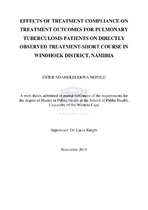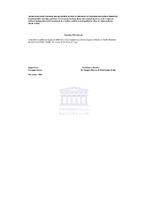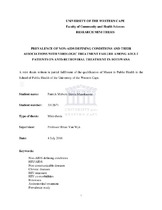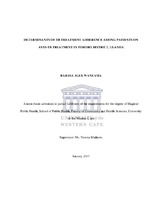| dc.contributor.advisor | Knight, Lucia | |
| dc.contributor.author | Nepolo, Ester Ndahekelekwa | |
| dc.date.accessioned | 2016-04-11T14:33:32Z | |
| dc.date.available | 2016-04-11T14:33:32Z | |
| dc.date.issued | 2016 | |
| dc.identifier.uri | http://hdl.handle.net/11394/4908 | |
| dc.description | Magister Public Health - MPH | en_US |
| dc.description.abstract | Tuberculosis (TB) is a major health problem worldwide, with an estimated 9 million new cases accounting for an estimated 1.5 million deaths in 2012. Non-compliance with TB treatment has become a major barrier to achieving global TB control targets. Namibia is one of the worst affected countries in Africa with a high case notification rate (CNR) of all forms of TB and relatively low treatment success rate compared to the WHO targets. The study aimed at investigating TB treatment compliance and measuring its association to patient characteristics and treatment outcomes, in determining the effects of compliance on treatment outcomes in Windhoek District. This information is crucial for TB programme management and development of targeted strategies. A quantitative observational analytic study using a retrospective cohort design was adopted. New adult Pulmonary Tuberculosis (PTB) patients treated under DOTS in Windhoek District between 1st January 2013 and 31st December 2013 were included in the study based on specified criteria. Data was collected from the patients TB treatment cards using an extraction tool. Selection and information bias was eliminated by using clearly defined inclusion and exclusion criteria using a pre-tested standardised tool. Statistical analysis using descriptive and analytic statistics was done using Epi Info 7 to determine compliance, treatment outcomes and to measure the associations. Overall treatment compliance (89%), initial phase compliance (97.2%) and continuation phase compliance (88.1%) were reported in the study. Age (OR=4.3 95% CI (1.72 – 9.90), p-value=<0.01) and type of area (OR=0.02 95% CI (1.00 – 1.13), p-value=0.05) were associated with compliance in the continuation phase. Overall, type of area (OR=0.03 95% CI (0.00 – 0.91), p-value=0.04) remains associated with treatment compliance. Treatment success is reported among 86.1% of patients. Poor treatment outcomes are associated with non-compliance in the initial phase ( =49.98, p-value=<0.01), continuation phase ( =98.81, p-value=<0.01) and overall ( =110.02, p-value=<0.01). Overall treatment compliance (89%) although higher than expected was lower than the WHO recommended 90% compliance. Very high compliance (97.2%) were reported in the initial phase of treatment whilst compliance was also lower than desired (88.1%) in the continuation phase. Non-compliance recorded in the continuation phase is in agreement with the literature. Age and type of area are associated with compliance as reported in the continuation phase and overall in this study is new contribution of knowledge. The findings suggest that treatment compliance is associated with treatment success in both phases of treatment and overall. Low compliance especially in the continuation phase could lead to poor treatment outcomes such as prolonged infections, relapse, high TB mortality and drug resistance leading to increased programme costs. The study concludes that non-compliance results in poor treatment outcomes highlighting the need for interventions that address compliance in all phases but specifically within the continuation phase and amongst those at risk of having reduced compliance such as those in rural areas and young adult patients aged (15 – 34 years). Recommendations to the District Management Team and TB Programme Managers include: identification of measures that promote treatment compliance; support and monitoring of TB patients’ compliance continuously; strengthening CB-DOT by increasing CB-DOT points and enhancing CB-DOT supporters’ capacity as well as strengthening record keeping as a monitoring tool to increase compliance and improve treatment outcomes. | en_US |
| dc.language.iso | en | en_US |
| dc.publisher | University of the Western Cape | en_US |
| dc.subject | TB treatment compliance | en_US |
| dc.subject | Drug resistance | en_US |
| dc.subject | Tuberculosis | en_US |
| dc.subject | Tuberculosis treatment | en_US |
| dc.subject | Directly Observed Treatment-Short Course (DOTS) | en_US |
| dc.title | Effects of treatment compliance on treatment outcomes for pulmonary tuberculosis patients on Directly Observed Treatment-short Course in Windhoek District, Namibia | en_US |
| dc.rights.holder | University of the Western Cape | en_US |




